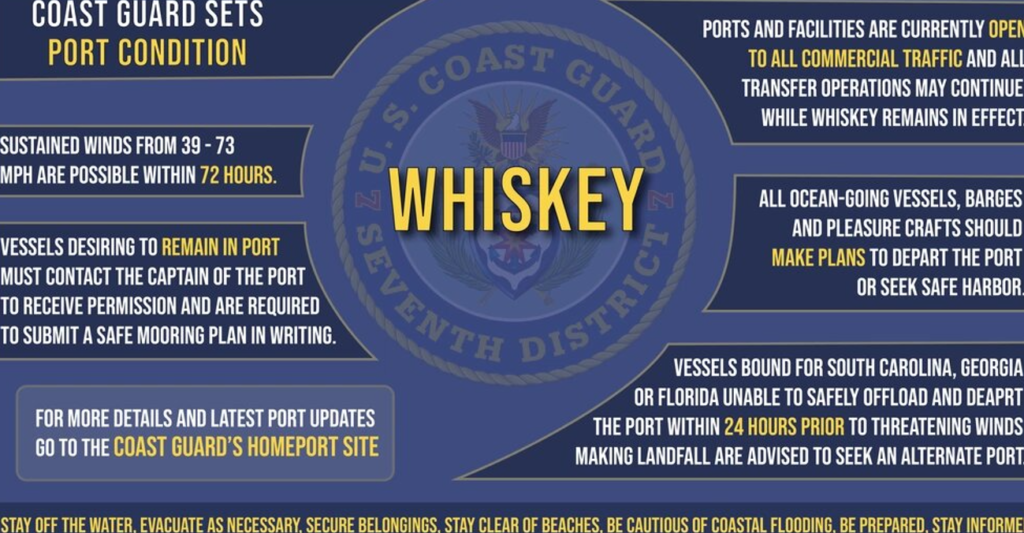JACKSONVILLE — The Coast Guard Captain of the Port for Jacksonville (COTP) set port condition Whiskey at 8 p.m. Saturday for the Port of Jacksonville and Fernandina due to the earliest Tropical Strom Fore Winds arriving within 72 hours.
These ports and facilities are currently open to all commercial traffic and all transfer operations may continue while Whiskey remains in effect.
Mariners are reminded there are no safe havens in these facilities, and ports are safest when the inventory of vessels is at a minimum. All ocean-going commercial vessels and ocean-going barges greater than 500 gross tons should make plans for departing the port.
Vessels desiring to remain in port must immediately contact the COTP to receive permission and are required to submit a safe mooring plan in writing. Vessels bound for the Port of Jacksonville and Fernandina are unable to depart 24 hours prior to threatening winds making landfall are advised to seek an alternate destination.
Pleasure crafts are advised to seek safe harbor. Drawbridges may not be operating if sustained winds reach 25 mph or when an evacuation is in progress. Port facilities are advised to review their heavy weather plans and take all necessary precautions to adequately prepare for the expected conditions. Mariners can view the latest port updates on the Coast Guard’s Homeport site.
If and when port condition Yankee is set, meaning sustained Tropical Storm Force winds are expected within 24 hours, vessel movement shall be restricted, and all movement must be approved by the caption of the port.
The Coast Guard is warning the public of these important safety messages:
- Stay off the water. The Coast Guard’s search and rescue capabilities degrade as storm conditions strengthen. This means help could be delayed. Boaters should heed weather watches, warnings and small craft advisories.
- Evacuate as necessary. If mandatory evacuations are set for an area, the public should evacuate without delay. Coast Guard personnel and other emergency responders may not be able to evacuate or rescue those in danger during the storm.
- Secure belongings. Owners of large boats are urged to move their vessels to inland marinas where they will be less vulnerable to breaking free of their moorings or to sustaining damage. Trailer-able boats should be pulled from the water and stored in a place that is not prone to flooding. Those who are leaving their boats in the water are reminded to remove EPIRBs and to secure life rings, lifejackets and small boats. These items, if not properly secured, can break free and require valuable search and rescue resources to be diverted to ensure people are not in distress.
- Stay clear of beaches. Wave heights and currents typically increase before a storm makes landfall. Even the best swimmers can fall victim to the strong waves and rip currents caused by hurricanes. Swimmers should stay clear of beaches until local lifeguards and law enforcement officials say the water is safe.
- Be prepared. Area residents should be prepared by developing a family plan, creating a disaster supply kit, having a place to go, securing their home and having a plan for pets. Information can be found at the National Hurricane Center’s webpage.
- Stay informed. The public should monitor the progress and strength of the storm through local television, radio and internet. Boaters can monitor its progress on VHF-FM channel 16. Information can also be obtained on small craft advisories and warnings on VHF-FM channel 16.
Information on how to prepare your boat or trailer for a hurricane can be found at the Coast Guard’s Strom Center webpage.
For information on Tropical Storm Ian progress and hurricane preparedness, please visit the National Hurricane Center’s webpage.

